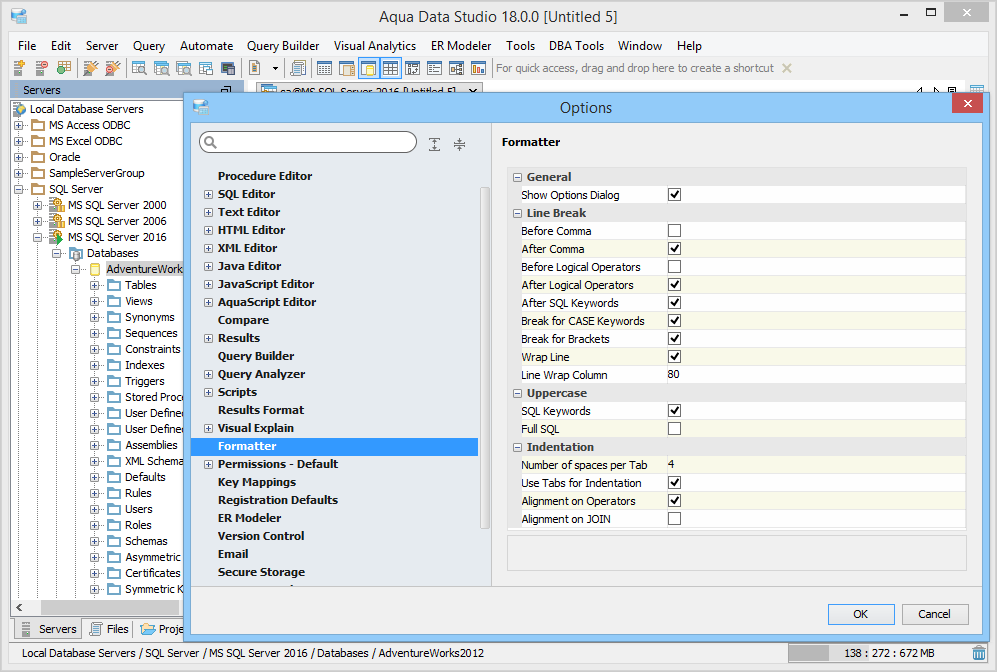
- #Sql formatter online access install#
- #Sql formatter online access drivers#
- #Sql formatter online access license#
- #Sql formatter online access download#
- #Sql formatter online access free#
The path is hard-coded, because this is a very simple self-extracting install, and the registry must find the files in the correct location.
The installer will only install into C:\Apps\Access SQL Editor.Please be aware of the following (known) limitations:
Since I had a bit of free time, I experimented with this. I have received several requests for per-user installation of Access SQL Editor. To convert a pasted row of Excel cells into Access SQL Editor, then convert them to a commented list (Version 1.1.18+) Operator symbols (commas, parentheses, +, -, etc.) When cursor is placed next to a brace, shows its matching braceĪggregate functions, SQL Server functions ODBC DRIVER=SQL Server UID= ) with the desired values.īelow is a partial list of styles with their descriptions. Sample SQL Server DSN-less connection string: Please note that you must have the characters ODBC before the connection string text.

Most connection strings can be found at.
To use a “DSN-less” ODBC connection instead, simply write or paste your connection string into the “ODBC Connect Str” text box. The system will then walk you through the process of creating a new user-wide or system-wide DSN. Choose the “Machine Data Source” tab to pick an existing DSN, or create a new one by choosing the “New…” button. If you click the ellipsis (…), you will see a system ODBC dialog. A DSN (Data Source Name) is a user-wide or system-wide database connection shortcut. There are two types of connection strings: DSN-based connection strings, and “DSN-less” connection strings. In the Properties dialog, you can enter your ODBC connection string. Create a new query or open an existing one. In more recent versions of Windows, such as Windows 7, SQL Server ODBC drivers are pre-installed.
You can usually download these ODBC drivers from the vendor of the database system that you would like to connect to. In order to use a pass-through query, you must have the correct drivers installed on your machine. The Query Filter also supports regular expressionsĪ pass-through query allows you to connect to a remote database, such as SQL Server, DB2, Oracle, MySQL, PostgreSQL, or Teradata.
Use the Query Filter to show only tables that contain a particular name. Access SQL Editor allows you to see your last revision, and the current state of the query side-by-side: When someone uses the built-in Access editor to edit a query, it will overwrite your formats. Unfortunately, there is no way to prevent edits outside of the Access SQL Editor. Ctrl + Shift + Q – Remove line comments from selected text. Ctrl + Q – Add line comments (double-dashes) to selected text. Icons are unzipped into %appdata%\Field Effect, LLC\MsaSQLEditor\icons. When you close and re-open the editor, it will display the new icons. This icon pack now comes bundled as a plugin when you download the editor, and it is automatically installed the first time you run it. To run the currently open query, click “Run.” Note you must save the query before running itĪccess SQL Editor has the ability to display custom icons, and to distinguish between query types (make table, delete, etc.). To redo the last operation, click “Redo,” or click Ctrl + Y. To undo the last operation, click “Undo,” or click Ctrl + Z. To find and replace text within your query, click “Find/Replace,” or Ctrl + H. To find text, click “Find,” or Ctrl + F. To remove them, highlight the text and press Ctrl + Shift + Q. To add comments to several lines of SQL at once, highlight all of the lines you wish to comment, and press Ctrl + Q. 
When complete, click “Save” or press Ctrl + S Another way to edit a query is to right-click it, and select “Design”
To open a query for editing, click the name of the query once to highlight it, then click “Open”. Once it is open, it will show you the tables in the Access (Jet) database that you are currently using. To open Access SQL Editor, use the Add-Ins menu in Microsoft Access. Go to Add-Ins/Access SQL Editor to use it.
The add-in will tell you that your license has been installed. Choose the MsaSQLEditor-license.xml file that you downloaded earlier, and click “Open”. Click the button that says “Please click here to install your license”. In Access 2010, the Add-Ins Menu is on the Database Tools tab Open Access’s Add-Ins menu, and select Access SQL Editor.





 0 kommentar(er)
0 kommentar(er)
